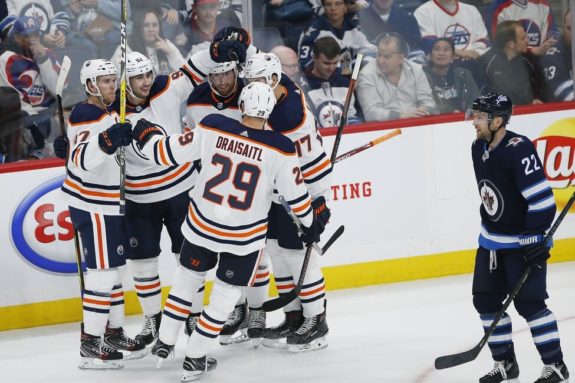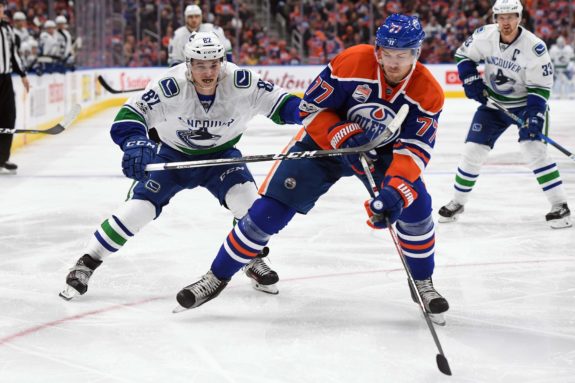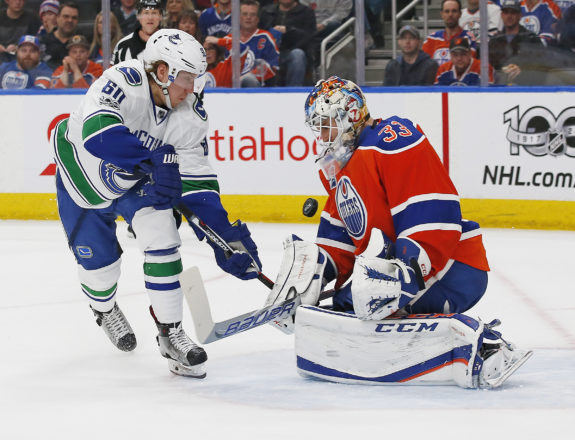
 Kelsey Krahn
The Hockey Writers
Kelsey Krahn
The Hockey Writers
35
Reads
0
Comments
Are the Oilers a Playoff Team?
Remember when the Edmonton Oilers bulldozed their way to the Stanley Cup Final in 2006? I was in Grade 9, rocking Oilers’ wristbands, an “Oilers Rule” t-shirt, and my outdated Mike Comrie jersey. It felt especially good cheering for the Oilers in British Columbia, amid moody Vancouver Canucks fans.
Now, I’m 28 years old, and I’ve only seen the Oilers make the playoffs once since then—in 2016-17. Will the embarrassment continue? The Oilers’ on-and-off play makes me wonder if the 2019-20 roster compares to the last two Oilers teams that made the playoffs or if the team is more similar to the postseason-missing squad from 2018-19?
Let’s let statistics answer that question by comparing the Oilers’ 2019-20 roster to the 2005-06, 2016-17, and 2018-19 teams.
Depth Scoring
The Oilers’ lack of depth scoring has been a hot topic for the last few years but it wasn’t always a huge problem. In 2005-06, they didn’t have superstars like Connor McDavid and Leon Draisaitl racking up a crazy amount of points, but they had more players producing.
2005-06 Oilers
The 2005-06 offensive roster—built around Ales Hemsky, Ryan Smyth, Raffi Torres, Shawn Horcoff, Fernando Pisani, Ethan Moreau—had five players with 50 or more points. Hemsky had the most points with 77. The Western Conference Final champions (take me back, please) also had four 20-goal scorers: Ryan Smyth had 36 goals, Raffi Torres scored 27 times, and both Shawn Horcoff and Jarret Stoll had 22.

On top of that, three other forwards reached double digits in goals: Hemsky (19), Pisani (18), and Moreau (11). Two defensemen scored between 10 to 20 goals: Marc-Andre Bergeron (15) and Chris Pronger (12). Let’s not forget that Michael Peca—who the Oilers acquired through a trade during the summer—also provided much-needed depth.
The defensive forward only tallied 23 points, which may have seemed like a disappointment at the time, but it would be a dream to have a depth player solid enough to notch the same this season, wouldn’t it?
Total goals from 20-goal scorers: 107
Goals from double-digit scorers (below 20): 75
2016-17 Oilers
The 2016-17 Oilers had less depth than 2005-06, but McJesus and others provided a decent combination of offensive power and offensive depth. What? Offensive help? For McDavid? It’s unheard of! The most notable players were Draisaitl, Pat Maroon, Milan Lucic, and Jordan Eberle. During 2016-17, McDavid’s 100-point season won him the Art Ross Trophy. Meanwhile, Draisaitl had 77 points, Eberle had 51 points, and Lucic had 50 points.
This roster had five players score 20 or more goals: McDavid (30), Draisaitl (29), Maroon (27), Lucic (23), Eberle (20). Let’s take a moment to reflect on the days when Lucic scored 23 goals. It’s also a good chance to reminisce about Eberle. What about Taylor Hall? Wayne Gretzky? Playoff berths? Anyone else tearing up? Just think about Tobias Rieder not scoring any goals last season, and you’ll be okay.
Meanwhile, two forwards put 10 or more goals into the back of the net: Ryan Nugent-Hopkins (18), Mark Letestu (16); and one defenseman, Oscar Klefbom, scored 12 times.
Total goals from 20-goal scorers: 129
Goals from double-digit scorers (below 20): 46
2018-19 Oilers
Say goodbye to depth, and hello to the dominance of McDavid and Draisaitl. Last season, three players had 50-plus points, while four had 20 or more goals: Draisaitl (50), McDavid (41), Nugent-Hopkins (28), Alex Chiasson (22).
Zack Kassian was the only forward to score his way into the double digits (15) and Darnell Nurse had 10. I don’t think it’s worth elaborating on the play from last season.
Total goals from 20-goal scorers: 141 (keep in mind that McDavid and Draisaitl scored 91 of them)
Goals from double-digit scorers (below 20): 25
It’s easy to see that depth scoring dropped last year.
2019-20 Oilers
Are the 2019-20 Oilers a continuation of last season or do they compare to playoff squads from the past?

So far both McDavid and Draisaitl have 50-plus points and 20-plus goals, but I expect players like James Neal (23 points), Oscar Klefbom (23), Nugent-Hopkins (20), and Kassian (26) to garner 50-plus points, which would mean that six players will—hopefully—reach the 50-plus point mark.
I also expect at least four players to score 20-plus goals: Draisaitl (22), McDavid (21), Neal (16), and Kassian (13). It’s possible for Nugent-Hopkins to reach 20, but he has only scored seven times near the halfway mark, so it’s up in the air whether he’ll make it or not.
I don’t think many players from this season’s roster will reach the double digits when it comes to goals, except for Nugent-Hopkins.
Do the 2019-20 Oilers compare more to the 2018-19 roster or to past playoff squads in regards to depth scoring? The 2019-20 Oilers need help when it comes to secondary scoring; they can’t just rely on the Dynamic Duo. This season’s team compares more to the 2018-19 roster in terms of offensive help. They don’t have the depth that propelled the 2005-06 and 2016-17 teams to the playoffs.
The Blue Line
The Oilers have struggled to land a high-end defenseman since Chris Pronger so infamously departed, but the franchise has had some hopeful candidates over the seasons like Ryan Whitney and Sheldon Souray.
2005-06
The Oilers’ defensive corps consisted of Pronger (56 points, plus-2), Bergeron (35 points, plus-3), Steve Staios (28 points, plus-10) Jason Smith (17 points, plus-1), Jaroslav Spacek (19 points in 31 games, plus-3), who the Oilers picked up in a trade on Jan. 26, but lost him to free agency in the summer.
Total points from notable defensemen: 155
Overall plus/minus from the defensive corps: plus-19
2016-17
The most notable defensemen of 2016-17 mirror theOilers’ blueliners of today—just swap Andrej Sekera for Ethan Bear. The defensive corps in 2016-17 excelled during the season: Klefbom (38 points, plus-7), Adam Larsson (19 points, plus-21), Sekera (35 points, plus-14), Kris Russell (13 points, plus-5), Matt Benning (15 points, plus-8).

It’s also important to note that Nurse had 11 points and an even plus/minus in 44 games, but I won’t include him in the overall calculation.
Total points from notable defensemen: 120
Overall plus/minus from the defensive corps: plus-55
2018-19
In 2018-19, the Oilers’ defensive corps did not improve, despite having similar blueliners as the previous season: Benning (17 points, plus-11), Russell (16 points, plus-5), Larsson (20 points, minus-28), Nurse (41 points, minus-5), and Klefbom (28 points, minus-11).
They may have accumulated two more points than the previous season, but the plus/minus differential is huge.
Total points from notable defensemen: 122
Overall plus/minus from the defensive corps: minus-28
2019-20
While it’s tough to compare final totals to a half season of play, it’s possible to predict where players may end up—points-wise—by the end of the season. For this calculation, I’ll exclude Larsson since he missed 22 games. Unfortunately, the points total and plus/minus look eerily similar to 2018-19—Benning (5 points, plus-8), Russell (4 points, plus-2), Nurse (18 points, minus-4), Klefbom (23 points, minus-20), Bear (12 points, minus-7).
Total points from notable defensemen so far in 2019-20: 62. They could reach similar totals to 2018-19 and 2016-17.
Overall plus/minus from the defensive corps so far in 2019/20: minus-21. Not good.
Do the 2019-20 Oilers compare more to the 2018-19 roster or to past playoff squads in regards to the defensive corps? When your supposed number one defenseman has a minus-20 half-way through the season, you know that it will be a fight to make the playoffs. The overall point totals will likely be the same as the 2016-17 and 2018-19 Oilers. However, the plus/minus totals seem to be going in the same direction as the 2018-19 Oilers.
So far, when it comes to depth scoring and the defensive corps, the 2019-20 Oilers compare more to the 2018-19 Oilers. Scary.
Special Teams
Will the 2019-20 Oilers’ special teams save the day? They just might.
2005-06
In 2005-06, the Oilers had average special teams. Their power play (PP) was at 18.14% (14th overall). The league average during this season was 17.68%, so they were slightly above average. While their penalty kill (PK) was 84.10%, the league average was 82.32%. The Oilers’ PK ranked eighth during this season.
2016-17
In 2016-17, the Oilers had an above-average PP—22.86% (fifth overall), while the league average was 19.10%. Not bad! The Oilers’ PK (80.72%) was in the middle of the pack (league average was 80.90%).

2018-19
The Oilers had an atrocious, 30th-ranked PK last season (74.80%). The league average percentage on the PK was 80.22% but the Oilers’ PP was above average: 21.17% (9th overall). The league average percentage on the PP was 19.78%.
2019-20
The Oilers are dominating when it comes to special teams in 2019-20. The franchise’s first-place ranked PP sits at 29.75%, while the league average is only 19.65%. It’s a beautiful thing! Their PK is also ranked seventh with 83.05% compared to the league average percentage of 80.35%.
Do the 2019-20 Oilers compare more to the 2018-19 roster or to past playoff squads in regards to special teams? They compare to no one! Okay, I’m getting ahead of myself. They have excelled on the PP this season, and their PP compares to none of the rosters mentioned in this article. But the PK, if we had to compare, looks most like 2005-06.
How Do the 2019-20 Oilers Compare to Previous Playoff Rosters?
The 2005-06 roster had the most depth and solid all-around defensive corps. They even had a legitimate number one defenseman: Pronger. While the 2016-17 roster also had depth, the defensemen played better (when you consider points and plus/minus totals). It’s also important to note that Cam Talbot had an outstanding year in net in 2016-17.
Meanwhile, the current Oilers have a lot of factors not going their way: lack of depth and wish-washy defensive play (from the entire team), which looks more similar to the 2018-19 roster, but the 2019-20 Oilers have some exciting things in their favour: two superstars and top-notch special teams.
The 2005-06 roster didn’t have McDavid and Draisaitl, in 2016-17, they were still breaking into the league. In 2019-20, the Dynamic Duo is in full force and neither playoff rosters had a PP as good as this season’s.

Can the Oilers rely on McDavid, Draisaitl, and special teams to make the playoffs, while playing with an average backline, a defensive-minded bottom six, and flaky goaltending (although Mikko Koskinen has been one of the only highlights during the 10 games)? We need to do what Oilers fans do best: hope.
The post Are the Oilers a Playoff Team? appeared first on The Hockey Writers.
Popular Articles

















































 Blackhawks Chicago
Blackhawks Chicago Panthers Florida
Panthers Florida Penguins Pittsburgh
Penguins Pittsburgh Rangers New York
Rangers New York Avalanche Colorado
Avalanche Colorado Kings Los Angeles
Kings Los Angeles Maple Leafs Toronto
Maple Leafs Toronto Bruins Boston
Bruins Boston Capitals Washington
Capitals Washington Flames Calgary
Flames Calgary Oilers Edmonton
Oilers Edmonton Golden Knights Vegas
Golden Knights Vegas Flyers Philadelphia
Flyers Philadelphia Senators Ottawa
Senators Ottawa Lightning Tampa Bay
Lightning Tampa Bay Islanders New York
Islanders New York Sabres Buffalo
Sabres Buffalo Red Wings Detroit
Red Wings Detroit Devils New Jersey
Devils New Jersey Hurricanes Carolina
Hurricanes Carolina Stars Dallas
Stars Dallas Jets Winnipeg
Jets Winnipeg Blue Jackets Columbus
Blue Jackets Columbus Predators Nashville
Predators Nashville Wild Minnesota
Wild Minnesota Blues St. Louis
Blues St. Louis Mammoth Utah
Mammoth Utah Sharks San Jose
Sharks San Jose Ducks Anaheim
Ducks Anaheim Canucks Vancouver
Canucks Vancouver






